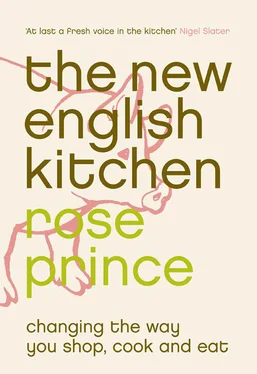to make a store of couscous
To create a store of 6 helpings, put a 240g/8oz teacupful of couscous in a plastic container that will take twice that amount and pour over 200ml/7fl oz cold water and 3 tablespoons of olive oil, stirring. Stir in a large pinch of salt and leave the couscous to swell. After 15 minutes, test the grains to see if they are tender – add a little more water if they are still dry. Use a fork to loosen the grains, then cover the container and put it in the fridge, where it will keep for about 5 days.
Couscous can be eaten very simply with boiled purple sprouting broccoli (see here) or with the baked chick pea recipe (see here). For a decorative, mighty feast, see the recipe below. Its flavour benefits from being made well in advance.
There are two ways to do this. Put the couscous in an ovenproof dish with a large knob of butter, cover with foil and place in an oven preheated to 180°C/350°F/Gas Mark 4 for 20 minutes. Alternatively, melt some butter in a pan, add the couscous and stir over a low heat until warmed through.
It must be 20 years since I first saw a bowl of hot couscous next to a grand platter of simmered meats and vegetables. It was in France, close to the Mediterranean coast, where merguez sausages, tabbouleh and harissa – a paste made with hot red peppers – could be bought in almost every grocery. Then it seemed so alien. Now couscous, like risotto and dal, has become neo-English; it has a second home and a new following. I like to cook it in a festive way, covering the table with all the component dishes: a large platter of braised lamb and poultry, plus steamed courgettes, carrots, runner beans and golden beetroot (when I can find it – the colour of red beetroot invades in an unpleasant way). There’s a bowl filled with fresh parsley and mint leaves, another with toasted nuts and golden sultanas, a dish of harissa, and finally a large pan filled with the cooking juices from the meat, ready to ladle over everything. It’s probably inauthentic, but it works.
Serves 8 generously (I am always happy to have leftovers from this for reheating later)
2 small, corn-fed chickens, jointed and skinned (ask the butcher to
prepare them for you, with the lamb)
8 lamb shanks, trimmed of fat
10 sprigs of flat-leaf parsley, finely chopped
4 onions, finely chopped
about 2 litres/3 1/ 2pints water or chicken stock
120g/4oz butter
2 teaspoons ground coriander
8 spring carrots, trimmed of leaves, then halved lengthways
4 courgettes, cut lengthways into quarters
about 10 runner beans, cut on the diagonal into 2cm/ 3/ 4inch lengths
240g/8oz string beans
4 golden beetroot, scrubbed, cut into quarters, and boiled for
30 minutes
salt and freshly ground black pepper
To serve:
leaves from 8 sprigs of parsley
leaves from 8 sprigs of mint
4 tablespoons flaked almonds, toasted in a dry frying pan until golden
4 tablespoons sultanas or 4 dried figs, sliced
harissa sauce (available from Middle Eastern shops and
specialist shops)
480g/1lb couscous, cooked (see here)
Put the chickens in one saucepan and the lamb in your largest pan. Throw half the parsley and half the onion into each pan. Grind about half a teaspoon of black pepper into each, then cover with the water or stock. Bring to the boil, skimming away any foam that rises to the surface. Turn down to a simmer and cook for about 20 minutes, then put half the butter and ground coriander into each pan. Let the chicken simmer for another 20 minutes, then turn off the heat. Continue to cook the lamb for 1 1/ 2hours; it should become very tender.
Put all the vegetables in a steamer, or simply put them on top of the lamb, and cook, covered, for 10–12 minutes, until they are just tender. Bring the chicken back to the boil (if there is no room for all the vegetables in the lamb pan, you could put the rest in with the chicken and cook as for the lamb).
To serve, put the herbs, almonds and sultanas or figs into separate bowls. Lift out the meat and arrange it on a large dish with the vegetables all around. Pour all the stock into a pan, then taste and season with salt and pepper if necessary. Bring back to the boil. Spoon the heated couscous on to each serving plate, followed by the meat and vegetables, then some of the herbs, nuts and sultanas or figs. Ladle over the stock to moisten, then offer the harissa to those who like a bit of heat in their food.
to make a store of bulgar wheat
Put 240g/8oz bulgar in a pan, cover with water and add a good pinch of salt. Bring to the boil and simmer for about 8 minutes, until tender. Drain and either use immediately or cool quickly and put into a sealed container. Store in the fridge for up to 5 days.
bulgar and parsley salad for barbecued meat
The salad to make during a parsley glut – you will need a lot of tender leaves.
Serves 2
2 tablespoons pine nuts
2 helpings of cooked bulgar wheat (see here)
4 tablespoons extra virgin olive oil
juice of 1/ 2lemon
a pinch of sea salt
8 sprigs of parsley, very finely chopped
2 spring onions, finely chopped
freshly ground black pepper
Toast the pine nuts in a dry frying pan over a medium heat until golden. Add them to the bulgar wheat with all the other ingredients and stir well. Eat with flat breads (see here) or grilled meat.
With lentils you enter the realms of pulses, and the many braised dishes that can be made with them. These are foods that can form a meal in their own right, without meat, fish or eggs, because they contain proteins and fats, but you can also feast on them with those foods. Lentils that have been hulled and split, such as red lentils, are best for soft, sloppy dal-like dishes to eat with hot flat breads (see here), while whole lentils belong in stews and salads.
You can make a store of lentils – green ones are good because they will stay firm in a sealed container – eating them once with a big meal, then dipping into them for little dishes of curry, or in salads with semi-soft boiled eggs and herbs.
Puy lentils are the finest. They have blue-grey marbled skins and cost more than standard green lentils, which are over twice the size. Cooked, they have a shiny, almost caviar-like quality and pop pleasingly in your mouth. Both types are easy to overcook, becoming a dry, powdery hash, so keep an eye on them when they are on the go.
Serves about 10
3 tablespoons vegetable oil
1 garlic clove, chopped
1 white onion, finely chopped
480g/1lb Puy lentils
1/ 2teaspoon dried thyme
sea salt and freshly ground black pepper
Heat the oil in a saucepan and add the garlic, onion, lentils and thyme. Swish them around in the warm oil for a minute or two, then cover with water (or stock). Bring to the boil and simmer for about 30 minutes; when cooked, the lentils should be tender inside, with firm skins. Add more liquid during cooking if you need to.
Remove the pan from the heat and tip the lentils into a large, cold bowl – it is important to stop the cooking process and – if you are storing them – to cool them quickly before putting them in the fridge. Season with salt and pepper. When the lentils are completely cold, cover and place in the fridge, where they will keep for about 5 days.
Use a combination of red wine and water for a rich lentil stew to eat with beef or game.
Undeniably pretty to look at, this recipe has become a picnic lunch regular.
Читать дальше












